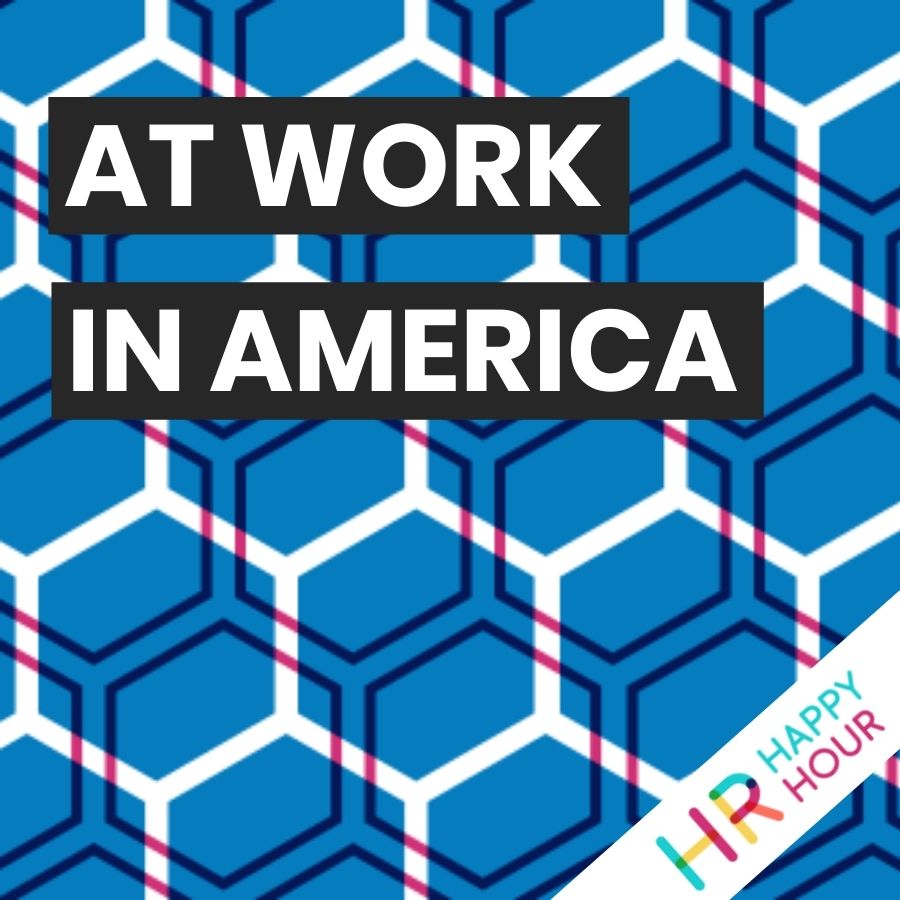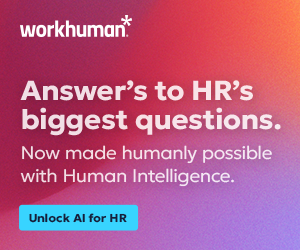Healthcare Equity and Empathy: Bridging the Gap for Underserved Communities
Hosted by

Trish Steed
Co- Founder and Chief Strategy Officer, H3 HR Advisors
About this episode
Healthcare Equity and Empathy: Bridging the Gap for Underserved Communities
Hosts: Steve Boese, Trish Steed
Guests: Jeni Mayorskaya, Founder & CEO of Stork Club and Dr. Jerrica Kirkley, Co-Founder and Chief Medical Officer of Plume
This episode of At Work in America is sponsored by Paychex, one of the leading providers of HR, payroll, retirement, and insurance solutions for businesses of all sizes.
This week we met with Jeni Mayorskaya and Dr. Jerrica Kirkley to talk about how inclusive health care can support the modern workforce while attracting and retaining talent.
– Importance of addressing underserved communitites
– Primary and gender affirming care
– The financial cost of healthcare in the U.S.
– The importance of cultural competency in healthcare
Thank you for joining the show today! Remember to subscribe wherever you get your podcasts!
Transcript follows:
Announcer 0:00
Welcome to At Work in America sponsored by Paychex. At Work in America digs in behind the headlines and trends to the stories of real people making a difference in the world of work. And now here are your hosts, Steve Boese, and Trish Steed.
Trish 0:28
Hi, and welcome to At Work in America, you are here with Trish and Steve is actually on a flight as we speak. So I’m very excited though, to be coming to you today with a very special show. We’re going to be talking about inclusive health care supporting the modern workforce to attract and retain talent, which, as we all know, is such a challenge in today’s job force. So we’re happy to welcome Jeni Mayorskaya and Dr. Jerrica Kirkley to the show today. Jeni is the founder and CEO of Stork Club, a next generation benefits provider that helps enterprises attract diverse top talent, drive better clinical outcomes, and reduce their largest healthcare cost, which is maternity care. Dr. Jerrica is Co Founder and Chief Medical Officer of Plume, a virtual Health Care Center of Excellence dedicated to the transgender, non binary and gender non conforming community which provides gender affirming care via telehealth. But before we welcome them to the show, I’d like to thank our sponsor Paychex. This episode of At Work in America is sponsored by Paychex one of the leading providers of HR, payroll, retirement and insurance solutions for businesses of all sizes. I would love to welcome both Jeni and Dr. Jerrica to the show. Welcome.
Dr. Jerrica Kirkley 2:40
Thanks so much for having me Trish. Glad to be here.
Jeni Mayorskaya 2:42
Thank you so much for having me.
Trish 2:45
So glad. Well, this is obviously a topic near and dear to my heart, I was saying before we started recording, you know, we’re going to be talking about a lot of different treatments and things that need to be made available to, to all genders that can help through the basically through your entire lifecycle, if you will. And there there are certainly areas where we haven’t seen as much support as we would like to going through the past couple decades. So Jeni, why don’t we start with you? You’re the founder and CEO of Stork Club. Why don’t you tell us a little bit about what got you interested in this, this career and how it all began?
Jeni Mayorskaya 3:34
Absolutely Trish. Well, I’m so glad that we all spend more time talking about this right now. Because it’s not like our life substantially changed, right. But the social stigma finally, is it’s becoming less effective. And we can have an open conversation. So for me, it all started in my early 20s When I was actually diagnosed with some reproductive health issues. And I don’t remember how my doctor actually told me, Hey, to just drop everything you’re doing right now. Go find a boyfriend and have a family right now, because you’re going to have really hard time conceiving later in life. And can you imagine like, I am 20 And like I run a company in simple reporting country. It was really heartbreaking for me, right? And I just got a lot of insight from my story and other people that when we think about overall family building or even maternity care, right, what it was a century ago, and how was graded and for whom it was graded, it would be mostly a heterosexual couple than women would have a baby before she even turned 20 and mostly stayed home after that. And this is just not how the modern family looks like anymore. Right? And that’s what was really the biggest inspiration to how close those gaps right and all was great The next generation of family build an overall reproductive care to support every person on their journey.
Trish 5:07
Yeah, I agree with you, it’s it seems like it would be shocking that someone would say that to you, right? When you have this sort of medical issue, I was working in my 20s, as well had pretty much the same conversation with as it related to infertility. It was, you know, my doctor told me, you need to find a less stressful job or stop working. And, you know, I mean, I would be mortified if someone you know, I have a daughter who’s 19. Right now, if someone were to tell her that I would, I would feel really bad for her. So. So I’m glad that you, you know, you took that as inspiration and a challenge to go out and create something that can help organizations really think proactively about health care, as you said, as it comes to reproduction. And just the way that we can even talk about it. Because I don’t know about you. But I think you know, 20 plus years ago, right, when I was having this conversation with my doctor, it just felt like I had no resources at all, do you find that employers are really open to getting into what kind of resources they could even have at their fingertips that they’re not aware of?
Jeni Mayorskaya 6:17
It’s a great question. I would say even now that there were so many articles about this, right? There were so many celebrities actually became very vocal about their journeys, and not just about family building, but overall reproductive health, right? Because, again, it’s changing over time. And then we also all became vocal, oh, wait a second. It’s not like it’s just about for telehealth, right. But it does affect overall physical and mental well being of every person. And so later in life, we might talk about menopausal symptoms, right, and how they affect us. Before we even consider building the family. We think about now, fertility, diagnostic and potential fertility cryopreservation, also for all genders, right? So what we observe is that the game really changed various the potential but then just passed it in like five years, which is such great news for everyone, right, we’re becoming more vocal, more employers provide this type of support for their members. And even traditional insurance companies already added more and more support, in terms of education, but also actual medical treatments, right. And clinical advancement is also there that we actually can have those options. And I think like some of the really looking like miraculous cases, then women, I think, even have birth, while they’re like in their 60s, this is like very, very extended hours cases. But there’s just like, shows what, even but is it capable of right? And I’m really excited about the future, because they do see that we can provide more support and enable people to build the family, regardless of those obstacles. And this is really great, right? Because one thing we really need to build in store club as a company is that nothing really more important to people than be able to build a family, regardless of all the obstacles and not not be alone.
Trish 8:17
Right? Well, thank you for sharing that. I think you’re right, the support is what’s really critical. Because you know, when you’re talking about it’s not just your health, which which it obviously is, but that’s such a personal thing. And when you feel like something is wrong, and you can’t fix it, and you don’t know how to go and get support. It’s just you start spiraling right. Before we dive into that even further, let’s bring Dr. Jerrika on and I would love you to just share what you what you went through in terms of the thought process of starting plume. I know you’re a co founder and tell us a little bit about plume, and then maybe how you’re working together with Jeni.
Dr. Jerrica Kirkley 8:56
Yeah, well, it’s already been an awesome start to the conversation and could add to a lot of what Jeni said, but to back up a little bit. You know, Plume. So we’re basically a virtual healthcare provider for the transgender, gender non conforming, non binary, expansive, gender diverse community, right, and all, all the ways that we show up in the world. And, you know, our vision is to transform healthcare for every translate. And we see ourselves doing that in a few different ways. But of course, providing direct patient care to folks and providing the highest quality, most affirming most accessible care that we can. And, and using our care platform, which is pretty unprecedented in terms of the numbers of folks we’re caring for under one clinical roof, which is amazing and humbling, being able to learn from that and taking those learnings to inform not only our care to keep improving the quality of our care, but the gender affirming care that all health care providers provide in this country and around the world and ultimately to To help inform policy change, right, and so that we really are talking about increasing access and fundamentally changing health care for all trans and gender diverse people. But where we started, is really similar to Jenny, you know, this was based on recognizing an unmet need. And also personal experience. And so I’m a family physician by training, had been providing gender affirming care, and a variety of settings for over 10 years, but mostly in federally qualified health centers, free clinics. And that’s always been my passion is trying to find ways to provide high quality care, to communities that have been underserved, that have been left out of that system that Ginni noted, was built for a very specific archetype in mind, right, which very specifically, a cisgender, heterosexual white men, and you’re really trying to think beyond that. And in a big way, but along with that, I’ve had my own personal journey. And you know, coming out as a trans woman over three years ago, and, and all the process processing that led up to that. And so seeing there was a massive need for care. A lot of trans folks not getting the care they needed, because of a lack of providers who just didn’t have the training, and clinical and cultural competence, of course, a lot of social stigma and bias. But then I’ve had to walk through that system myself, right. And then even with a lot of knowledge and privilege, as a physician, it’s been challenging just to get my own health care needs met. So taking all that combined, you know, that was really the impetus for starting to really try to provide the best experience possible for all trans and gender diverse folks.,
Trish 11:40
Thank you so much for sharing your story. I mean, you’re really both pioneers. And I love that, as with many things in life, it often starts with a very personal journey that you’re on and seeing that, that need that, you know, other people are having. So I applaud you, and thank you for for both sort of taking that to the next level. Right. Not just taking taking on for yourself, but taking it on for others. And and Dr. Jerrica, you mentioned underserved communities, you know, that’s one, one area, I think, especially when it comes to gender affirming care, they certainly don’t have access, right, that that maybe even a very small percentage of the population would would have to begin with. So yes, I think you’re you’re both sort of addressing a really important need. Jeni, I’d love you to maybe talk a little bit about the partnership with plume, and how the two of you or you had a recent announcement, you know, in the news and and how you’re working together, and then maybe we can talk a little bit about, you know, how that can impact employers today?
Jeni Mayorskaya 12:49
Of course, yes, Trish? Well, we’re very excited to partner with whom, as they’re definitely one of the leading providers of this type of care, specifically gender affirming care, right. And I’m sure Jerrica will share more exactly how did they get to this status and how they’re helping. But overall, overall, I would share what we had sort of doing, why we have this partnership in place is we ensure that one employer is really evaluate what type of benefits they want to add to the set of supportive system, right for the employees. There are so many solutions out there, right. And we can all have empathy, that usually there’s teams that were child benefits, or people are still lean, and they have to a analyze what needs to be added be by all the solutions. And we actually put them all together, right to engage members and actually provide value. And it’s very, very challenging. So what we see and they want to highlight this is why why do we dedicate our lives to AI and so many people have created this type of care, right? What, based on what we see, based on what we see right now is it’s really high priority problem to solve. Specifically, not only family building, but overall, we all know during college, so many people experienced mental health issues, right? It’s feel there were serious problems to solve. And it might actually still not just through access to therapists, but actually address the real problems, right. And being able have control over your reproductive health is a very important solution to also mental health issues. For example, again, knowing that you can have a family even if you’re not in a relationship, right so you have the ability to cry preserve egg or sperm, which just five years ago was probably like a whole sci fi but now so many people do this right. And again, we can openly talk about this and then being able to create a family as well. All right, based on very different terms, sometimes it’s for single parents, sometimes it’s for non traditional family, right? Sometimes it’s for parents who are just older in age, etc.
Jeni Mayorskaya 15:13
And then when we talk about overall comprehensive health, this is where it’s important that at Stork Club, we provide support for everyone’s reproductive journey, right. And also for people who are going through lifetime transitions, right, whereas it’s a menopause, or low testosterone, which is a testosterone level changing age to eight women as well, right. And of course, gender affirming here is critical if we want to be really truly inclusive. And if we really want to ensure that we bring that support to people who are in the transition, but also might be either now or later would like to know the femoral right and being able to do so and, and just be who they are, the way we select our providers, we really want to make sure that we give access to the best providers available on the market. And of course, we do that in together, right. But also, what’s the next generation healthcare, it’s not only then you can walk in, in the office with a doctor, but then you can have this access through an app, right, you can have a telehealth visit. And this is where we found that home is doing literally the best job in the market by providing easy access to care, but really vetted providers. And the way our partnership works is that we actually provide access to gender affirming care through again, vetted providers as the part of the commercial insurance. So as I mentioned, there are so many points solution for employers to search for, right, and we make their job so much simpler. We package it all together in sport clubs. So actual employers can that as as a part of their existing health plan to make it easy, and that it’s much easier for members to navigate this type of gear as well.
Trish 17:08
Yeah, thank you so much. You know, it’s interesting, you I jotted down when you mentioned that it’s, you know, we’re now able to openly talk about all of these types of care that we we need throughout our lives. I know in the in the press release, you know, we talked about the the high percentage of people that are actually impacted by one of the various things that you mentioned in terms of whether it’s low testosterone or going through menopause. So it’s fair to assume that there are people in your workplace going through all of these different needs, right? And so being able to talk openly is just the first step really, for a company to start thinking about.
Jeni Mayorskaya 17:48
I so much agree with this. And just to share, you know, some numbers, maybe for our listeners, we see that about 20% of the American workforce experience, menopause each year, right. And this is like pretty conservative data. We think about this, basically, like old people with ovaries, at some point will experience menopause, it’s more like a question of the theory of Ethington. It’s about 40% of men over the age of 45, would lose the ability to produce efficient software. And then I’m sure to grow quick and share some of the details on the agenda from here as well.
Trish 18:27
Yes, and Jerrica. I’d love to throw it to you, Dr. Jericho, because, you know, we talked a little bit at the at the beginning about people who are choosing their workplace, not just because they might need care, but they want to make sure, especially you know, Gen Z, wanting to have a workplace that is very inclusive of everyone’s needs. So I’d love to get your perspective just on that, and then maybe dive a little bit deeper into some of the specific needs and gender affirming care that could be given that isn’t being given right now by many employers.
Dr. Jerrica Kirkley 19:02
Yeah, for sure. You know, we’ll start with the first point, it’s absolutely true that I think, increasingly see a lot of our workforce choosing employers based on how they’re taking the stance socially, right. And that means not only for, of course, their internal employees and the benefits, they’re offering the programming they’re offering around acknowledging many different communities and backgrounds, but also how they’re showing up in the world in regards to you know, I think in our space, intensely pressured by anti trans legislation, for example, right, but we see this across the health care spectrum, we talk about reproductive rights, you know, and abortion access and other issues like a highly politicized and so yeah, short answer. Folks are looking at that as they choose employers, and I think especially in younger generations with Generation Z and younger, who are now a company Rising, you know, this point 20 to 30% of our workforce and will continue to grow over the next significantly and quickly over the next five to 10 years. We’re definitely seeing that in a lot of different companies and in our company to, you know, we kind of have a two pronged path for providing gender affirming care, you know, for the trans community and gender diverse community, but also building a workplace that as much as we can, is inclusive, you know, that over two thirds of our company as trans or gender diverse, with a lot of intersectional backgrounds within that, and have to think critically about how we craft our benefits of course, too. And so that is a high priority for for a lot of folks. And remind me the second part of your question.
Trish 20:47
Well, I just love to hear about what are some of the different therapies or different solutions that are being offered to people who are either trans or gender diverse? What type of needs are they having that weren’t being met? That now thanks to plume or other, you know, maybe partnerships, like with store club, that are now being made available to the trans and gender diverse community?
Dr. Jerrica Kirkley 21:17
Yeah, I mean, it really starts with talking about the landscape of care, really now, but as it has been historically, and that is starting to shift, as you noted, and they’ll talk about that. Where most folks have tried to get care is usually in what we call the primary care network, right, walking into your local primary care clinic and trying to get care. And in those cases, you know, upwards of a third of folks are trans folks are actively discriminated against whether it be physical or verbal violence in a health care facility, specifically, right. And that doesn’t even count for how you get to that healthcare facility, your transportation, your home, your neighborhood, you know, all the steps you have to take, just get there. And there’s still the discrimination and violence within healthcare facilities. And over half of trans and gender diverse folks have to teach their providers, their physicians, how to provide care for them, which is the wrong flow of information. And so that’s what it looks like, because there is not universal training when it comes to, again, training on clinical and cultural competence in medical schools, and nursing schools, you know, physician assistant schools, social work schools, all healthcare training grounds do not have this as universal education. And so it creates a massive backlog and provider capacity and availability. Now, if you’re lucky enough to live in a city, a major market city where you have maybe an LGBTQ plus health center, for example, a little bit higher chance of having, you know, an affirming experience, but can be really high wait times upwards of six to 12, to even 18 months, and some of these clinics just to get in which, unfortunately, can be the difference of life and death for many people. And if not that, you know, significant consequences on our health.
Dr. Jerrica Kirkley 23:04
And then there’s the black and gray markets where folks are unfortunately having to turn to other alternatives outside the healthcare system. Because the they’re just really aren’t options. And especially when you get into rural areas where there literally are no providers for many miles. And of course, which is not ideal, and it’s unsafe and unsupervised. So that’s what it looked like for a long time and still does to a large degree. Now, what we’ve done over the last three years, is anchored on a virtual model. And that’s been super important. And I think helpful to increase that access, we’re now in 45 states taking care of over 13,000 patients. And, and that’s unprecedented. As I said before, like you just can’t do that in a brick and mortar setting. Even with best intentions, you just don’t have the number of people available to do that type of work to in our case, and this is one of the principles behind our care is really providing care, not only learning from our community, but through care providers who share the lived experience of our community. Again, you know, over half to two thirds of our clinical team or to our company, are gender diverse in some way. And so that’s super important in terms of understanding the needs of the community you’re serving. And that’s really hard to do just based on how our population is distributed, if you’re trying to do that in one area. And so that virtual model, you know, just to put a couple of statistics out there. Surveys show that over 95% of trans folks almost all utilize telehealth in 2022 alone, and that 85% of trans and gender diverse folks avoided going to a healthcare facility in 2021 because of fear of discrimination or mistreatment, even when they had a medical need, right. And so, so that virtual access point has been really critical for our community. It has been for a long time but of course COVID Amplified that For us and for our community, so of course that are benefiting nouns from telehealth in a way they haven’t before. And you know, the services, specifically gender affirming hormone therapy certainly is one of the harder things to get. But mental health services also very hard, you know, finding a therapist who is understanding have you, but also available and as affordable. And so when we were approaching that is through peer led support groups, which are included in the membership. And led by peers, they’re much more cost effective, and we’re already seeing great impact in terms of mental health outcomes. So there’s just a couple of different ways and specific services that we’re providing, and that can be really hard to get in the general community.
Trish 25:45
Yeah, thank you for sharing those. I think that when you’re talking about it isn’t just a physical thing, right? It is that that mental, the emotional, it’s all of the things and I was actually shocked when you’re saying, you know, these even to get treatment can take, you know, 18 months plus it’s sometimes that’s too long, right for someone to wait that long, and and you don’t want them to make other choices that are are certainly not going to be in their benefit. You talked a little bit about cost Jeni, I know that that you have a perspective on cost as well. Could you maybe talk a little bit more broadly, because you mentioned obviously, you know, infertility, menopause, low testosterone as some other treatments? What, what are the costs associated with offering benefits like this in your organization? Because I want to make sure that we’re addressing anyone listening who might think like, oh, this is really cost prohibitive? And I know that that’s not necessarily the case at all, in fact.
Jeni Mayorskaya 26:47
Yeah, thank you Trish, a very, very important question, right? Because when we’re going as a country, pretty tough, economical situation, many companies asking themselves, right, should we buy more benefits right now? Should we wait? And what’s more important, right? Should we invest in one set of services or others? I would say the overall how we see most of the employers thinking about this is Dewey’s financial cost, like what are the rural healthcare spend, right. And we all know that health care in America is really expensive. But we also see that there are most expensive categories, and historically would happen is that, in general, it’s almost always like male and go on healthcare and how it works, right. And it’s quite written in that a female angle and perspective also I introduced so overall together fertility maternity and newborn cost, which are so so connected rather than basically snowballed. Usually, if some of the decisions are done in the wrong way in the beginning, our top health care costs in the United States, and it’s actually about $300 billion overall annual spend in the United States. And it’s bigger in comparison with mental health or even diabetes. Just for a second, like mental health and diabetes together, I feel it’s smaller spend in the US versus maternity fertility newborn right. So now, when we think about this, companies are paid as costs, right. And as our society is changing, more and more people actually do use IVF. In order to have a baby, right? More people do prep, preserve fertility, in order to be able to have a family later in life. And right now, companies won’t be not providing this type of benefits. But people already do this out of pocket. Right? And how does this affect employers? Well, here’s how, depending on what type of clinic people go, if they go to mediocre clinics, which are cheaper, right, and that’s why they might be going to those clinics, their rates for multiple births might be higher. So what it means is that, on average, IVF is unfortunately quite often results in twin or a triplet, birth and pregnancy.
Jeni Mayorskaya 29:12
And usually clinics, which are a little bit more expensive. They have design package and their rates for multiple births. What’s it’s called is significantly lower, because they basically optimize they run a protocol which reduces this risk, right for twins or triplets. But if there will be the toilet report, first, because people pay out of pocket for the year, then the cost for overall maternity case and for newborn right, will be actually higher for employer because in most of these cases, it’s actually going to be a premature birth. And this is where it basically cascades into this action, right. And then potential readmission for the postpartum recovery as well as newborn issues and these type of pregnancies. And basically there is even like terminology in our market is called multimillion dollar babies a million dollar babies, which are relevant to idea, right? This is what employers are paying for, without the knowing about this, right that like this is what might be causing this. And that’s why when we really evaluate the cost of this type of care, who should be evaluated? And hey, is it possible that we actually can save and reduce the overall cost, right, the employers already paying. So when we think about overall cost of the treatments, let’s say, depending on the location in the United States, and we also provide services globally, pretty much in any country. So this is also important to see that prices are very different for the services, right. And in the US, within IVF have different costs idea for like, basically, having an ability to get birth would cost around $20,000. And if we think about this, again, how many cycles what person but you, right? So when we provide these type of evolution, here’s the expected cost and utilization, we run all those numbers, but we also project what type of outcomes people would be getting. And what we see was four o’clock due to our design, we call it managed care, right? That we significantly reduce the number of treatments people have to utilize in order to achieve birth. And also significantly improved outcomes by reusing multiple births. And in this way, reducing the overall employer maternity fertility, newborn cost. And we we see that those programs actually ROI positive, and they can significantly reduce the cost employed or the pain, especially again, in those hard times.
Trish 31:45
Yeah, thank you for sharing that. I think that’s something we don’t think about it. And obviously, if you’re not comfortable talking about it on the front end, then you’re not going to be prepared for not just the financial costs, but the emotional cost the the missed work. And, you know, I was someone who I had a great employer, who paid for part of it, but I went through IVF, you know, almost 20 years ago. And you’re right, I had multiple births, and it was just a financial strain on my family. It was emotional strain. It was a mental strain. It was it was wonderful. Right? It was the it was the outcome we wanted. But yes, there was a cost and there was a cost to my productivity for a long time, because of just the, the mental stress. Dr. Jerrica, I’d love to have you comment on sort of the similar perspective when it comes to sort of proactively offering gender affirming care, versus if you don’t offer it, and maybe what the costs are at the back end that we’re not even thinking about whether it’s physical or mental or emotional.
Dr. Jerrica Kirkley 32:52
Yeah, and be happy to think about cost with our community. One of the big things comes up that we talked about a lot at plume is trying to provide the right care at the right time. And what we see is that the transgender diverse community do tend to be higher utilizers of care, but that’s oftentimes higher and higher utilizers of care in the wrong place, right. So such as the emergency room, or other settings, where care is going to be more expensive, because the access points for care. And the practice of care, as you mentioned, can be so limited. And so things snowball, whether that’s mental health, other physical health conditions, and to the point where you know, folks are indeed up into the ER, and care is really expensive. And so, you know, our goal really is to provide be as proactive as possible. And whatever way we can do that. And certainly, you know, in a virtual format, lots of care we can provide with traditional medication management, whether that’s hormone therapy, depression, anxiety, other basic primary care needs. And again, also approaching that from a non medical, non clinical angle. With mental health support, community support, and logistical support. You know, there’s a lot of things that folks don’t think about when it comes to the transgender diverse experience, that are fairly taxing. And that can be things like trying to change your name or your gender marker, and, you know, access different care referrals. And so providing that guidance can go a long way. Again, not even the prescription, but can be important for maintaining improving mental health and quality of life. So, so yeah, so that’s where we see a lot of the cost burden. We do know that that trans folks are disproportionately affected by various physical and mental health conditions, right. And we think about certainly depression and anxiety, but also things like cardiovascular health, HIV and AIDS. And so there’s a lot of certainly prevention work, that we have a lot of work to do and meeting our community’s needs. And again, the reason that a lot of folks are not getting that prevention work is because of intimidation of entering the healthcare system, lack of trust, and, and just lack of opportunity and care providers for that care.
Trish 35:18
Yeah, thank you for sharing. I want to ask you, and and this would be just, you know, if I’m someone who does not have any sort of program or training, or you mentioned, cultural competence earlier, when you were talking about training for the medical community, to be able to work with people who are, you know, gender diverse, there is no training really, unless you I guess, if you seek it out, specifically on your own, maybe, for HR professionals, and yet, they’re sort of the frontline from a work perspective of whether it’s from the hiring, right, and making sure that you’re inclusive from a hiring perspective. But also, that’s the team of people who are sitting down with the benefit providers and trying to make sure that you are even thinking about all of the various services, that and types of care you would need in order to be inclusive for someone who’s trans or, or gender diverse. Could you maybe address if I’m an HR person, I’m listening to this. And I know that we don’t do this in my organization at all, what is the best way or the most appropriate or, or culturally sensitive way to even ask to get this started in my organization? Because I don’t know that we know necessarily how to do that.
Dr. Jerrica Kirkley 36:36
Yeah, that’s a great question. There are, there are a lot of organizations that do that specific work. And so you know, even something like a, you know, we’d call it sort of like a transgender, diverse competency, one on one training for workplace. Right. And that’s a starting point. This can be something that’s done live or recorded module that all employees watch and participate in as they onboard, and periodically through the course of their employment. But usually, those organizations are going to have other resources as well. And so whether that’s like frameworks on, you know, what you need to be thinking about, right, in terms of selecting the technology using your company, whether that’s your HR platforms, their communication platforms, you know, how are folks acknowledged in those platforms, whether it be their names, or gender identities, their pronouns, right. And there’s a lot of things to think about there. But that can be a good starting point there actually, like consultant groups and organizations that specialize in that. And oftentimes, you know, who are staffed by gender diverse folks themselves, who’ve walked through that. So that can be a good place to start in seeking that out and having that initial conversation, and they can usually provide a roadmap and different options of how you can engage them.
Trish 37:54
Good. Thank you so much for sharing that. Yeah, I think it’s like, any group, right that over the years that in human resources, we have to address, you have to educate yourself first, right in order to bring it to life in your organization. And you have to make sure that, that you are being as open as possible and unafraid to ask questions. Right? Curiosity is okay, if it’s with good intent, and to try and bring services to all of your employees who who need it and education to them. Jeni, I know you were maybe going to add on there.
Jeni Mayorskaya 38:28
Yeah, I actually wanted to add that the overall base, I think it’s quite complex, there were so much to understand here, right? Because we’re way overdue you to provide this type of support. That’s why companies like door club Oh, we also see healthcare consultants, provide webinars, right, or just simple educational sessions with pro club, for example, provide monthly webinars for our members, educate them on very different topics, as well as do provide open webinars for HR benefits teams and healthcare consultants, the best way to navigate this is just look at our LinkedIn and you will be able to see this. And my recommendation would be working closely with healthcare consultants, as well as very often they can point you to the right direction. And don’t be afraid to start this conversation with your healthcare consultants and just join the webinars because it takes some time to understand the topic and it’s quite, quite complex. So starting advanced, that would be my recommendation.
Trish 39:32
I love both your suggestions. I think, you know, it’s, I feel like we’ve gone through this before with, you know, maybe people who are, whether it’s physically disabled, different mental abilities. It’s the same thing it’s sort of like I think, you know, within a work kind of find you’re a little bit nervous like that. You don’t want to offend someone and ask something the wrong way so that you just don’t ask the question and so nothing ever gets fixed. Right. So I think it’s about like you’re both saying, reaching out to consultant to know how to properly navigate this and bring sort of the right questions into the organization, right, so that you can identify who needs the services, who needs this type of assistance and support. Because the end goal is that you want all of your employees to feel like they are a part of the organization, right, and that they’re cared for. And, you know, I think my, you know, over 20 years spent in human resources before doing what I do now, it was that was what it was about, you want employees to feel like they’re cared for when they’re within your walls of your organization, and that they’re able to show up and bring their best abilities forth. And if they’ve got all these other things weighing on them, that certainly will, will be a barrier. Before we close, I want to make sure that I mentioned both websites, we have join stork club.com. And then we also have get Plume that people can go to Dr. Jerrica why don’t you go first, where can people connect with you? Or is there a certain thing on the website that you want to point them to as an as an entry point? Where can they learn more?
Dr. Jerrica Kirkley 41:08
Yeah, certainly could learn more about them going to the website, we have quite a bit of resources and extensive blog collection, to learn about our services, what we do and different topics within that. For me, you can always find me on LinkedIn. Plume is on social media, at Plume Clinic. So you can check us out there as well.
Trish 41:29
Wonderful, Jeni, how about you?
Jeni Mayorskaya 41:32
Yeah, as for me, definitely join store club.com, our website, a lot of information, we also provide the insights, statistics concept, how to think about this in our blog. And then me personally, the best way to reach out is LinkedIn, I check it very frequently. And I think it’s a really great tool to connect also a little bit we were just talking today, buckling different end goal in the deeper dive, we also will be covering on a webinar on June 27. We have a LinkedIn or LinkedIn. So I highly recommend, it’s actually called from 20s to 40s. And just to walk for the entire lifetime, but also again, for everyone who’s joining right, including gender diverse population, then again, everyone.
Trish 42:22
tThank you for sharing that, you know, I’m hoping that you have one out there for those of us who are 50s plus, because as we talked to the like, before we started recording, I mean, you know, it’s it’s one of those things, you know, you hit menopause or different times in your life. And no one tells you these answers, right, you’re just out there kind of a little bit. So I think it’s great that you both have so many resources. And thank you for being a resource today for all of the listeners. I know we plan on sharing this as widely as possible. And I hope you’ll both come back on the show, we’d love to hear from you, you know, in six months to a year and hear how things are going and maybe even you know what else we can be doing to be helpful and, and spreading the word so that people become more curious and ask those questions.
Jeni Mayorskaya 43:10
Thank you so much Trish for bringing this topic and bringing our voices to the people leadership community, right, we cannot make this big change without working on this together. So I’m very grateful to be a part of it. And thank you so much Jerrica for the partnership.
Dr. Jerrica Kirkley 43:27
Yeah, thank you Trish for having us. Really great conversations. And thank you, Jeni, for doing the amazing work that you do. And likewise excited about the partnership. And I think, you know, hopefully this demonstrates how healthcare providers and employers can can partner to really meet patient needs. So thanks for having us.
Trish 43:42
Yes, you’re welcome. Well, listen, thank you to everyone who’s listening and for joining us today on today’s episode, thank you again to our friends at Paychex for just constant support and making this all possible. A big shout out to Steve Boese who I know is very sad that he was not able to record with us but I’m sure we will get him on the next time that we have you both back on. For now please again go to join storkclub.com or plume.co for further information and to connect and we will catch you next time and bye for now.
Transcribed by https://otter.ai
Talk to us
If you want to know more about any aspect of HR Happy Hour Media Network, or if you want to find out more about a show topic, then get in touch.










